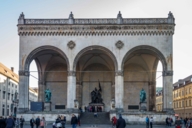
Anyone familiar with the Loggia dei Lanzi in Florence may not believe their eyes when they get their first glimpse of the Feldherrnhalle (Field Marshalls’ Hall) on Odeonsplatz square – the grand building with its three rounded archways looks almost identical to its Italian role model.
Of course, the Feldherrnhalle is a little younger than the original copy in Florence: It was built between 1841 and 1844 by the architect Friedrich von Gärtner on behalf of King Ludwig I, who – as well as being a passionate admirer of Ancient Greece – was also a big fan of Italian art. While he was still Crown Price, the monarch took countless trips to Italy and even owned his own villa in Rome.
The Feldherrnhalle plays an important role in Munich’s history: King Ludwig I had the structure built as a tribute to the glory of the Bavarian army. The two bronze statues in the side arcades were cast from melted canons: they depict the Count of Tilly, a victorious general in the Catholic League during the Thirty Years’ War, and General von Wrede, who commanded Bavarian troops in the battle against Napoleon’s army.
Half a century later, Prince Regent Luitpold had a “Bavarian army memorial” built in the middle of the hall in 1894. The bronze scene by Ferdinand von Miller the Younger was designed to pay tribute to the Franco-German War of 1870/71. The two striding lions made from South Tirolean marble on each side of the steps were not added until 1906.
On 9 November 1923, the Feldherrnhalle was the place where Hitler’s attempted putsch was defeated, leading to the hall becoming an iconic destination for the National Socialists and a propaganda tool for the party. When he assumed power, Hitler had a massive bronze tablet installed, containing a swastika for the “martyrs of the movement” and the phrase “Und ihr habt doch gesiegt!” (“And you were victorious after all!”).
An SS guard of honour watched the memorial at all times. People were only permitted to pass if they performed a “Deutsche Gruß” (Nazi salute). To avoid this ritual, many locals took a detour down Viscardigasse behind the Feldherrnhalle, which led to the alleyway being nicknamed “Drückebergergasserl” (literally “shirkers’ alley”). Gold paving stones there now remind passers-by of this civil resistance.
Nowadays, locals and tourists meet on the steps of the Feldherrnhalle to relax after some shopping or sightseeing, while enjoying the view down Ludwigstrasse all the way to Siegestor (gate). In July every year, the Feldherrnhalle also transforms into an orchestra pit that hosts world-famous classical musical stars during an open air classical music event on Odeonsplatz.